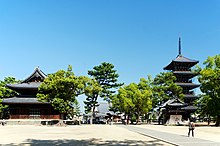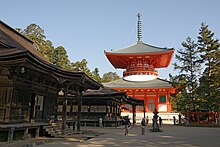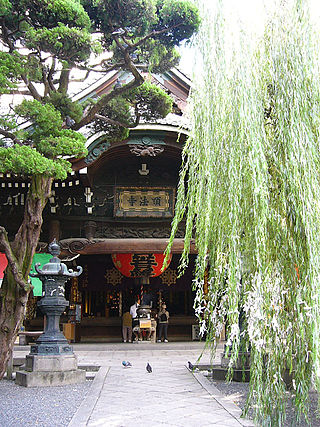Fukui

This is a list of Buddhist temples, monasteries, stupas, and pagodas in Japan for which there are Wikipedia articles, sorted by prefecture.









Jōdo Shinshū, also known as Shin Buddhism or True Pure Land Buddhism, is a school of Pure Land Buddhism. It was founded by the former Tendai Japanese monk Shinran.

Enryaku-ji is a Tendai monastery located on Mount Hiei in Ōtsu, overlooking Kyoto. It was first founded in 788 during the early Heian period (794–1185) by Saichō (767–822), also known as Dengyō Daishi, who introduced the Tendai sect of Mahayana Buddhism to Japan from China. The temple complex has undergone several reconstruction efforts since then, with the most significant taking place in 1642 under Tokugawa Iemitsu. Enryaku-ji is the headquarters of the Tendai sect and one of the most significant monasteries in Japanese history. As such, it is part of the UNESCO World Heritage Site "Historic Monuments of Ancient Kyoto ". The founders of Jōdo-shū, Jōdo Shinshū, Sōtō Zen, and Nichiren Buddhism all spent time at the monastery. Enryaku-ji is also the center for the practice of kaihōgyō.

Rennyo was the 8th Monshu of the Hongan-ji Temple of the Jōdo Shinshū sect of Buddhism, and descendant of founder Shinran. Jodo Shinshu Buddhists often referred to as the restorer of the sect. He was also known as Shinshō-in (信証院), and posthumously Etō Daishi (慧灯大師). During the conflict of the Ōnin War and the subsequent warfare that spread throughout Japan, Rennyo was able to unite most of the disparate factions of the Jodo Shinshu sect under the Hongan-ji, reform existing liturgy and practices, and broaden support among different classes of society. Through Rennyo's efforts, Jodo Shinshu grew to become the largest, most influential Buddhist sect in Japan.

Jōdo-shū, also known as Jōdo Buddhism, is a branch of Pure Land Buddhism derived from the teachings of the Japanese ex-Tendai monk Hōnen. It was established in 1175 and is the most widely practiced branch of Buddhism in Japan, along with Jōdo Shinshū. In the general classification of Buddhism in Japan, the Jōdo-shū, the Jōdo Shinshu, the Ji-shu and the Yuzu Nembutsu shu are collectively classified into the lineage of Jōdo Buddhism.
Ikkō-shū (一向宗) or "single-minded school" is usually viewed as a small, militant offshoot from Jōdo Shinshū Buddhism though the name has a complex history.

Hongan-ji, also archaically romanized as Hongwanji, is the collective name of the largest school of Jōdo Shinshū Buddhism. 'Hongan-ji' may also refer to any one of several actual temple buildings associated with the sect. Nishi Honganji (西本願寺) and Higashi Honganji (東本願寺) are two major temples in Kyoto.

Sculpture in Japan began with the clay figure. Towards the end of the long Neolithic Jōmon period, some pottery vessels were "flame-rimmed" with extensions to the rim that can only be called sculptural, and very stylized pottery dogū figures were produced, many with the characteristic "snow-goggle" eyes. During the Kofun period of the 3rd to 6th century CE, haniwa terracotta figures of humans and animals in a simplistic style were erected outside important tombs. The arrival of Buddhism in the 6th century brought with it sophisticated traditions in sculpture, Chinese styles mediated via Korea. The 7th-century Hōryū-ji and its contents have survived more intact than any East Asian Buddhist temple of its date, with works including a Shaka Trinity of 623 in bronze, showing the historical Buddha flanked by two bodhisattvas and also the Guardian Kings of the Four Directions.

Nishi Hongan-ji (西本願寺) is a Jōdo Shinshū Buddhist temple in the Shimogyō ward of Kyoto, Japan. It serves as the head temple of the sub-sect Honganji-ha.
Senju-ji (専修寺), also known as Takadayama (高田山), refers to a pair of temples which are the chief Buddhist temples of the Takada branch of Jōdo Shinshū, a Japanese Buddhist sect. The current head temple, Honan Senju-ji, founded in the 15th century, is located in Mie Prefecture. The original head temple, Hon-ji Senju-ji, founded in 1225, is located in Tochigi Prefecture. Both temples are governed by the same abbot.

The Honpa Hongwanji Mission of Hawaii is a district of the Nishi (West) Hongwanji branch of Jodo Shinshu Buddhism, a school of Mahayana Pure Land Buddhism.

Ōya-dera (大谷寺) is a Buddhist temple of the Tendai sect in the city of Utsunomiya, Tochigi Prefecture, in northern Kantō region of Japan. The temple is famous for its bas-relief carvings on a cliff face. The honzon of the temple is a bas-relief stone statue of Senjū Kannon. The temple is 19th stop on the Bandō Sanjūsankasho pilgrimage route of 33 temples sacred to Kannon in the Kantō region.

Gionzan An’yō-in Chōraku-ji (祇園山安養院長楽寺) is a Jōdo shū Buddhist temple in Kamakura, Kanagawa, Japan. Famous for its rhododendrons, it was named after its founder's posthumous name. The main object of worship is Amida Nyorai, but it also enshrines Senju Kannon, Goddess of Mercy. An’yō-in is Number three of the 33 temples of the Bandō Sanjūsankasho pilgrimage circuit.

Buddhism played an important role in the development of Japanese art between the 6th and the 16th centuries. Buddhist art and Buddhist religious thought came to Japan from China through Korea. Buddhist art was encouraged by Crown Prince Shōtoku in the Suiko period in the sixth century, and by Emperor Shōmu in the Nara period in the eighth century. In the early Heian period, Buddhist art and architecture greatly influenced the traditional Shinto arts, and Buddhist painting became fashionable among wealthy Japanese. The Kamakura period saw a flowering of Japanese Buddhist sculpture, whose origins are in the works of Heian period sculptor Jōchō. During this period, outstanding busshi appeared one after another in the Kei school, and Unkei, Kaikei, and Tankei were especially famous. The Amida sect of Buddhism provided the basis for many popular artworks. Buddhist art became popular among the masses via scroll paintings, paintings used in worship and paintings of Buddhas, saint's lives, hells and other religious themes. Under the Zen sect of Buddhism, portraiture of priests such as Bodhidharma became popular as well as scroll calligraphy and sumi-e brush painting.

The Rokkaku-dō, official name Chōhō-ji, is a Buddhist temple in Kyoto, Japan, said to have been established by Prince Shōtoku. The name comes from its main hall's hexagonal shape. This temple is part of the Saigoku Kannon Pilgrimage.

This is the glossary of Japanese Buddhism, including major terms the casual reader might find useful in understanding articles on the subject. Words followed by an asterisk (*) are illustrated by an image in one of the photo galleries. Within definitions, words set in boldface are defined elsewhere in the glossary.
The Jodo Shinshu Buddhist Temples of Canada are a group of temples and fellowships that are affiliated with the Nishi Hongan-ji of Kyoto, Japan, the mother temple of the Jodo Shinshu sect of Buddhism.

Ōtani-ha is a Japanese Buddhist movement. It belongs to Jōdo Shinshū, also known as Shin Buddhism. The movement has approximately 5.5 million members.
Jodo Shinshu Hongwanji-ha, commonly called Honganji-ha, is a Japanese Buddhist organization. It is a sub-sect within Jodo Shinshu. Its head temple is Nishi Hongan-ji. It is the largest Jodo Shinshu sub-sect, the second largest being Otani-ha.

Japanese Buddhist architecture is the architecture of Buddhist temples in Japan, consisting of locally developed variants of architectural styles born in China. After Buddhism arrived from the continent via the Three Kingdoms of Korea in the 6th century, an effort was initially made to reproduce the original buildings as faithfully as possible, but gradually local versions of continental styles were developed both to meet Japanese tastes and to solve problems posed by local weather, which is more rainy and humid than in China. The first Buddhist sects were Nara's six Nanto Rokushū, followed during the Heian period by Kyoto's Shingon and Tendai. Later, during the Kamakura period, in Kamakura were born the Jōdo and the native Japanese sect Nichiren-shū. At roughly the same time, Zen Buddhism arrived from China, strongly influencing all other sects in many ways, including in architecture. The social composition of Buddhism's followers also changed radically with time. Beginning as an elite religion, it slowly spread from the nobility to warriors and merchants, and finally to the population at large. On the technical side, new woodworking tools like the framed pit saw and the plane allowed new architectural solutions.